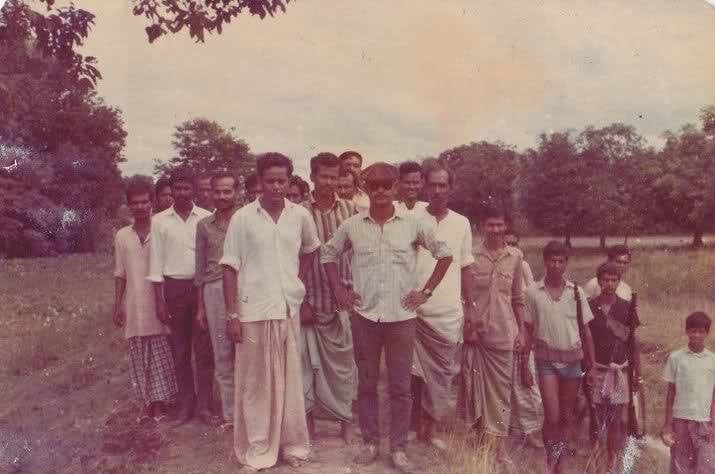The discourse around Ziaur Rahman is, quite unsurprisingly, full of malicious slanders pushed by Awami League propagandists. And when slander is preposterous or insufficient, the regime’s thought police resorts to airbrushing him out of history. For example, it is not possible to deny that Major Ziaur Rahman was a decorated freedom fighter who received the second-highest gallantry award, Bir Uttam, from Sheikh Mujibur Rahman. This does not, of course, stop Awami Leaguers all the way to Hasina Wajed from trying to denigrate Zia’s contribution to the war effort. But recognising the futility of that, they simply pretend that Zia didn’t fight in 1971.
This is, of course, hypocritical and ironic given the Awami League’s incessant cacophony about upholding the ‘true history’ of 1971!
Unfortunately, the regime’s hypocritical historical revisionism has resulted in even many otherwise admirers of the late president stumbling if asked what Zia did after he made the iconic radio speech in March 1971. We know that he participated in the Teliapara Conference with other officers in April 1971, even before the Mujibnagar government was officially sworn in. We also know that he commanded the Bangladesh Army’s first regular brigade, named the Z-Force after him. As the brigade commander, one would not have expected him to be present at each of the battles the Z-Force fought. Rather, one would attribute the battlefield record of the brigade to its commander. Where did Zia’s soldiers fight in 1971?
This piece tries to fill in some of the gap created by the regime propagandists around Zia’s role in 1971.
After the radio declaration
Ziaur Rahman iconic radio speeches at the onset of the war — where he unequivocally and categorically informed the world about Bangladesh’s independence and the armed resistance against the Pakistani occupation — identifying himself at the risk of facing a firing squad for mutiny if captured is well known. In the first days of the war, the 8th East Bengal Regiment that Zia led into revolt were attacked by a full Pakistani Division, supported by three commando and three infantry battalions. Outnumbered and outgunned, Zia retreated from the Chittagong, but not without a fight. Over a dozen Pakistani officers were killed, along with scores of soldiers, before Chittagong was occupied by the invaders.
After the Teliapara Conference of Zia was given the responsibility of commanding Sector 1 that covered greater Chittagong including the Hill Tracts as well as part of the greater Noakhali.
Z-Force created
In early June, the Mujibnagar government decided to raise a regular infantry brigade to fight the Pakistani occupation forces in formal set piece battles. Major Ziaur Rahman was chosen to command this brigade. Handing over the command of Sector 1, Zia moved to Teldhala, which is in the Garo Hills, on the border of Bangladesh and Meghalaya. He was accompanied by Captain Oli Ahmed and Captain Sadeq. Within a few days, Major AZM Aminul Huq moved to Teldhala from Ramgarh (Chittagong) with the 8th Bengal (Zia’s regiment when the war began). On 17 June, Major Shafayat Jamil joined them from Rayganj (West Dinajpur, India) with his 3rd Bengal. Captain Hafizuddin arrived from Bangaon with the 1st Bengal on 25 June. In addition, Major Moinul Hossain Chowdhury moved from Calcutta.
On 7 July, the first infantry brigade of the Bangladesh army was formed by integrating three battalions — the 1st, 3rd, and 8th — of the East Bengal Regiment. The regular soldiers of these battalions were joined by students, farmers, and other Mukti Bahini volunteers. They were trained in weeks on combat skills that usually require months.
The brigade was renamed Z-Force in September, after its commander Major Zia.
The first battle of Kamalpur
Kamalpur had strategic importance because it was on the road connecting Jamalpur, Tangail and Dhaka. Any eventual march to Dhaka would have required control of this post. Accordingly, Pakistani defence in the post was very strong. In addition to 20 hit-and-run attacks, there were four set-piece battles here, on 31 July, 22 October, 14 November, and 24 November. In the third battle, Major Taher lost his leg. There were 197 KIA on the Bangladeshi side here, while 220 Pakistanis (including a major) were killed. Pakistanis kept reinforcing the post, and Kamalpur wasn’t liberated until 4 December, when the Indians joined the war.
Recognising Kamalpur’s strategic importance months before the eventual Indian attack, Zia asked Major Moin (then commanding the 1st Bengal) to hit the Kamalpur border post in the third week of July. Major Moin suggested a guerrilla attack, opining that his troops were not capable of winning in a set-piece battle. Zia overruled Moin because he knew that even if victory isn’t achieved in the first battle, the experience would still be invaluable for his soldiers. Thus the first battle was set in motion.
Major General Jamshid’s 36 Ad Hoc Division was in charge of defending the Pakistani occupation of greater Mymensingh. The Kamalpur-Jamalpur route to Dhaka was defended by Brigadier Qadir’s 93 Brigade, which comprised two regiments — 33 Punjab and 31 Baluch. The 31 Baluch was in charge of defending Kamalpur, Nakshi and Baromari. They were assisted by East Pakistan Civil Armed Force and razakars. Captain Ahsan Malik commanded the Kamalpur post, which had three 81mm mortars.
Against this, the total strength of Major Moin’s 1st Bengal was 850.
Contrary to the AL effort at airbrushing him out of the history of 1971, Zia himself was present to coordinate the first battle of his brigade. Around 3 am on 31 July, Zia and Moin took a position with the 1st Bengal about 1100-1200 yards from the Pakistani base. According to the plan, Captain Mahbub was behind the enemy base, Captain Hafiz and Captain Salahuddin were 600 yards inside the enemy line, Major Moin and Flight Lieutenant Liaquat were in the nearby jute field, while Zia was on a hillock with light canon and heavy machine gun. There was a cut-off party which mined the Kamalpur-Buksheegunj road.
By 3.30am, Captain Salahuddin Mamtaz entered the enemy base with his two platoons. Pakistanis retreated inside the bunker, and there were hand-to-hand combat. Captain Salahuddin was killed by machine gun fire in the post’s community centre — he would be posthumously awarded Bir Uttam.
Upon hearing about Salahuddin Mamtaz’s death, Moin commanded Captain Mahbub to attack from the rear. As Mahbub didn’t respond, Moin moved out in the open for better wireless reception. He was hit by enemy fire, his wireless operator was killed and the set was damaged. By then, daylight had broken and the attack appeared to have failed. Zia, Moin and Liaquat led the rescue effort amid enemy fire.
Meanwhile, enemy reinforcement of three truckloads of troops and two 120 mm mortars were hit by mines on the road from Buksheegunj.
A total of 35 freedom fighters were killed in the battle, against 50 or so Pakistanis. While Kamalpur remained in Pakistani hands, the enemy morale was hit hard while the morale of the Mukti Bahini was boosted. General Sam Manekshaw visited the Z-Force headquarters to praise the Bangladeshis.
Battle of Nakshi
Around 3.45 am on 3 August, 8th Bengal hit the Pakistani border post of Nakshi (in Sherpur). The freedom fighters got to around 50 yards of the post but failed in the face of Pakistani mortars and mines. Captain Amin Ahammed and Lieutenant Modasser led the assault while Major Aminul Huq (the battalion commander) provided the firing cover. Again, Zia coordinated the battle himself. Captain Amin was hit by enemy fire, and Major Aminul Huq saved him while risking his own life.
Liberated Roumari
On 6 August, Zia charged Lt Nurunnabi of the 3rd Bengal to create a defence perimeter around the liberated area of Roumari. Nurunnabi created a citizen’s committee on 8 August. On 11 August, Zia visited the area with the Indian Major General Gulbat Singh Gill.
With the Z-Force firmly securing the area, the civilian administration of the People’s Republic of Bangladesh started operating in Roumari, with fully functioning police, the magistracy, the postal service, customs, medical service and schools. The customs department generated 150,000 takas a month from cross-border trade, and Zia was scrupulous in maintaining appropriate accountability for this fund.
Victory in Sylhet
As the autumn started chilling towards the winter, preparations were being made for a coordinated attack across the border that would eventually end in the liberation of Dhaka. To this end, the Z-Force was deployed in Sylhet in October. Initially, they ramped up regular guerrilla attacks, for example besieging the Chhatak Cement Factory on 12 October in an internationally reported operation.
By 20 November, which was Eid-ul-Fitr that year, the soldiers were ready for the long-awaited offensive. Attacks across the entire Indo-Bangladesh border came the following day, and 21 November is now celebrated as Armed Forces Day in Bangladesh. Facing certain defeat in the eastern theatre, Pakistanis chose to attack India in the west on 3 December, and the Indian troops entered Bangladesh the following day.
The three battalions of the Z-Forces converged on Sylhet as the war drew to a close. The 1st East Bengal came to the town from the northeast, the 3rd from the northwest, and the 8th from the south. The Z-Forces entered Sylhet on the night of 14 December. About 7,000 Pakistani soldiers, including 125 officers, surrendered when the war was over.
Of course, there is much more to Zia’s role than the above in the nine months of the war in 1971. For example, his efforts to build a professional, disciplined army began on the first day of the war and would continue until his very last day. History abounds with examples of armed men stepping into politics. But the Bangladesh army in 1971 is a rare example where soldiers, having started an armed resistance when political leaders vacillated, voluntarily relinquished power. Ziaur Rahman demonstrated the utmost valour by serving the nation under Tajuddin Ahmed-led government during the war. It is a pity that the post-liberation government failed to utilize Zia’s leadership qualities. But that is the subject for another day.
*This piece draws on blog posts from 2007-12 acknowledging the work of former bloggers aliased Dasotto and Tacit, as well as ‘Role of Z-Forces in Bangladesh’s War of Independence’, which was based on the dictation given by Ziaur Rahman and published in the Weekly Bichitra on 13 July 1972.


